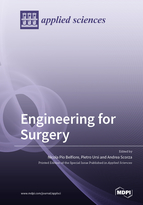Engineering for Surgery
A special issue of Applied Sciences (ISSN 2076-3417). This special issue belongs to the section "Mechanical Engineering".
Deadline for manuscript submissions: closed (6 June 2020) | Viewed by 39993
Special Issue Editors
Interests: functional design; MEMS/NEMS; dynamic simulation of multi-body systems; robotics; topology; tribology
Special Issues, Collections and Topics in MDPI journals
Interests: multimodal and multidisciplinary rectal cancer treatment; with specific reference to mini invasive surgical treatment; adrenal gland bariatric mini invasive surgery; gastric surgery
Special Issues, Collections and Topics in MDPI journals
Interests: mechanical and thermal measurement systems and instrumentation; design and testing of biomedical instrumentation; experimental mechanics applied in biomedical fields
Special Issues, Collections and Topics in MDPI journals
Special Issue Information
Dear Colleagues,
the developments of new surgical methods have been often inspired by the availability of new technologies, design methods, and materials. This evolution has been successfully demonstrated by the recent growth of
- smart surgical tools
- micro/nano robots for surgery
- minimally invasive procedures for general, lung, gynecologic, head and neck, heart, neuro-spine, vascular, urological surgery.
One way to explain how the cooperation between Technology and Surgery works consists in interpreting it as a customer-provider relationship where Engineering offers new technological developments to the Surgery’ demand. Among the recent evolutions in Engineering, the following fields have found a large application to Surgery:
- design, mechanics, dynamics, kinematics, measurements, control, microelectronics, information technology, telecommunications, pneumatic, fluid dynamics, and nanotechnology.
However, regarding the complex and multifaceted cooperation between Engineering and Surgery as a mere offer-demand relationship would be such a limited way! We believe that any possible development in Surgery could be supported by a proper collaboration with the Engineering counterparts, while almost any new development in Engineering could be successfully applied to improve surgical operations. Both alliances need a strong and very integrated partnership and an enduring team work.
For these reasons, we are very glad to launch the present special issue and call for original or review papers which describe any recent experience of cooperation between surgery and engineering.
Contributions from all fields related to the subject are welcome to this Special Issue, such as the following general topics:
- Laparoscopic Surgery
- Endoscopic Surgery
- Robotic Surgery
- Natural Orifice Transluminal Endoscopic Surgery (NOTES)
- New technologies for intraoperative imaging
- MEMS/NEMS and microsystems for surgery
More specific topics will be also welcome, such as, and not limited to,
- New technologies for training of residence and young surgeons in minimally invasive surgery;
- Transanal Endoscopic Microsurgery (TEM) and Transanal Minimally Invasive Surgery (TAMIS);
- Ethics: ethical issues in the application of autonomous robots in surgery;
- Education: new trends in teaching–learning methods and information technology.
Prof. Dr. Nicola Pio Belfiore
Prof. Dr. Pietro Ursi
Prof. Andrea Scorza
Guest Editors
Manuscript Submission Information
Manuscripts should be submitted online at www.mdpi.com by registering and logging in to this website. Once you are registered, click here to go to the submission form. Manuscripts can be submitted until the deadline. All submissions that pass pre-check are peer-reviewed. Accepted papers will be published continuously in the journal (as soon as accepted) and will be listed together on the special issue website. Research articles, review articles as well as short communications are invited. For planned papers, a title and short abstract (about 100 words) can be sent to the Editorial Office for announcement on this website.
Submitted manuscripts should not have been published previously, nor be under consideration for publication elsewhere (except conference proceedings papers). All manuscripts are thoroughly refereed through a single-blind peer-review process. A guide for authors and other relevant information for submission of manuscripts is available on the Instructions for Authors page. Applied Sciences is an international peer-reviewed open access semimonthly journal published by MDPI.
Please visit the Instructions for Authors page before submitting a manuscript. The Article Processing Charge (APC) for publication in this open access journal is 2400 CHF (Swiss Francs). Submitted papers should be well formatted and use good English. Authors may use MDPI's English editing service prior to publication or during author revisions.
Keywords
- Surgery
- Engineering
- Laparoscopy
- Endoscopy
- Robotics
- MEMS/NEMS
- NOTES
- TAMIS
- TEM








